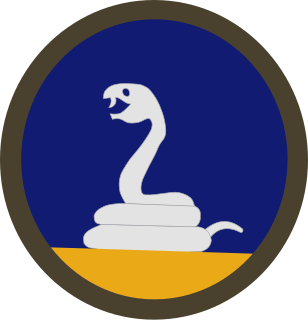
The II Corps was an army corps of the British Army formed in both the First World War and the Second World War. There had also been a short-lived II Corps during the Waterloo Campaign.

The Fourth Army was a field army that formed part of the British Expeditionary Force during the First World War. The Fourth Army was formed on 5 February 1916 under the command of General Sir Henry Rawlinson to carry out the main British contribution to the Battle of the Somme.

The 55th Infantry Division was an infantry division of the British Army's Territorial Army (TA) that was formed in 1920 and existed through the Second World War, although it did not see combat. The division had originally been raised in 1908 as the West Lancashire Division, part of the British Army's Territorial Force (TF). It fought in the First World War, as the 55th Division, and demobilised following the fighting. In 1920, the 55th Division started to reform. It was stationed in the county of Lancashire throughout the 1920s and 1930s, and was under-funded and under-staffed. In the late 1930s, the division was reduced from three to two infantry brigades and gave up some artillery and other support units to become a motorised formation, the 55th Motor Division. This was part of a British Army doctrine change that was intended to increase battlefield mobility.

Fourteenth United States Army was a fictitious/military deception field army, under the command of John P. Lucas, developed as a part of Operation Quicksilver as a part of the fictitious First United States Army Group.

The 76th Infantry Division of the British Army was raised during the Second World War to defend the Norfolk coast against a possible German invasion, before being transformed into a training division in late 1942. It was responsible for providing final tactical and field training to soldiers who had already passed their initial training. After five additional weeks of training, the soldiers would be posted to fighting formations overseas. The formation was used as a source of reinforcements for the 21st Army Group, that was fighting in Normandy. After all available British army troops left the United Kingdom for France, the division was disbanded in September 1944.

The 77th Infantry Division of the British Army was formed in 1941, during the Second World War, from the re-organisation of the Devon and Cornwall County Division. During its existence the division changed roles several times. The division's initial role was coastal defence, protecting Devon. On 20 December 1942, it was converted into a training formation, known as a reserve division. In this capacity, the division provided final tactical and field training for the infantry that had already passed their initial training. After five additional weeks of training, the soldiers would be posted to fighting formations overseas. The division also had a tank brigade attached to provide training in armoured warfare.

The 40th Division was an infantry division of the British Army active during the First World War, where it served on the Western Front. It was a division of Lord Kitchener's New Army volunteers, mostly "bantam" recruits of below regulation height. It was later briefly reformed as a fictional deception formation in the Second World War, and during the early years of the Cold War was recreated a third time to garrison Hong Kong.

The 61st Infantry Division was an infantry division of the British Army, raised in 1939 as part of the expansion of the Territorial Army in response to the German occupation of Czechoslovakia. The division was created as a duplicate of the 48th Infantry Division, and was assigned to home defence duties.

The 80th Infantry (Reserve) Division was an infantry division of the British Army formed at the beginning of 1943, during the Second World War. For the twenty months that the division existed, it was a training formation. It was made responsible for providing final tactical and field training to soldiers who had already passed their initial training. After five additional weeks of training, the soldiers would be posted to fighting formations overseas. Notably, the division was used as a source of reinforcements for the 21st Army Group, which was fighting in Normandy. After all available troops left the United Kingdom for France, the division was disbanded.

The 11th Division, an infantry division of the United States Army, was activated twice during the First World War. During the Second World War the division was notionally reactivated as part of Fortitude South II.
During World War II the British Army made extensive use of fictional army formations, as part of strategic or tactical military deceptions. Their use was pioneered by Dudley Clarke during the North African campaign. Clarke eventually formulated an elaborate order of battle deception to mislead the Axis high command as to the strength of Allied forces in the region. Based on these successes the London Controlling Section made extensive use of notional formations during Operation Bodyguard - a deception operation ahead of the June 1944 Normandy Landings.

The US 55th Infantry Division was a 'phantom division' created in October 1943 to cover the departure of the US 5th Infantry Division from Iceland. An entirely notional force, its existence was reported to the Germans only through controlled agents as Iceland was too far from Europe to make use of radio deception.

The 58th Division was an infantry division created in 1915 as part of the massive expansion of the British Army during World War I. It was a 2nd Line Territorial Force formation raised as a duplicate of the 56th Division. After training in Britain, the division joined the British Expeditionary Force (BEF) on the Western Front in 1917. It saw action at the battles of Arras and Passchedaele in 1917 and the German spring offensive in 1918. It then took part in the Battle of Amiens and the final Allied Hundred Days Offensive of the war. The division was recreated during World War II as an imaginary 'deception' formation.

XIV Corps was a British infantry corps during the First World War. During the Second World War the identity was recreated for deceptive purposes.

The US 59th Infantry Division was a 'Phantom Division' created in May 1944 as part of Fortitude South II. to cover the deployment of the US 35th Infantry Division to Normandy.

The 9th Airborne Division of the United States Army was a military deception created in 1944 as part of Fortitude South II

The US 25th Armored Division was a 'phantom division' created in 1944 as part of Fortitude South II to replace the real US 5th Armored Division when that unit was deployed to Normandy.

The US XXXIII Corps was a 'Phantom Unit' created in 1944 as part of Fortitude South II.
The US XXXVII Corps was a 'Phantom Unit' created in 1944 as part of Fortitude South II, a military deception by the Allied nations during the build-up to the 1944 Normandy landings.

The United States Army created a large number of notional deception formations that were used in a number of World War II deception operations. The most notable fictional US formation was the First U.S. Army Group (FUSAG); this field army was originally intended as the main invasion force for the Invasion of Normandy, however that was renamed to the 12th Army Group. FUSAG remained in existence on paper and was used during Operation Fortitude South to divert Axis attention to the Pas de Calais area.


















